2013 DACIA SANDERO airbag
[x] Cancel search: airbagPage 19 of 146
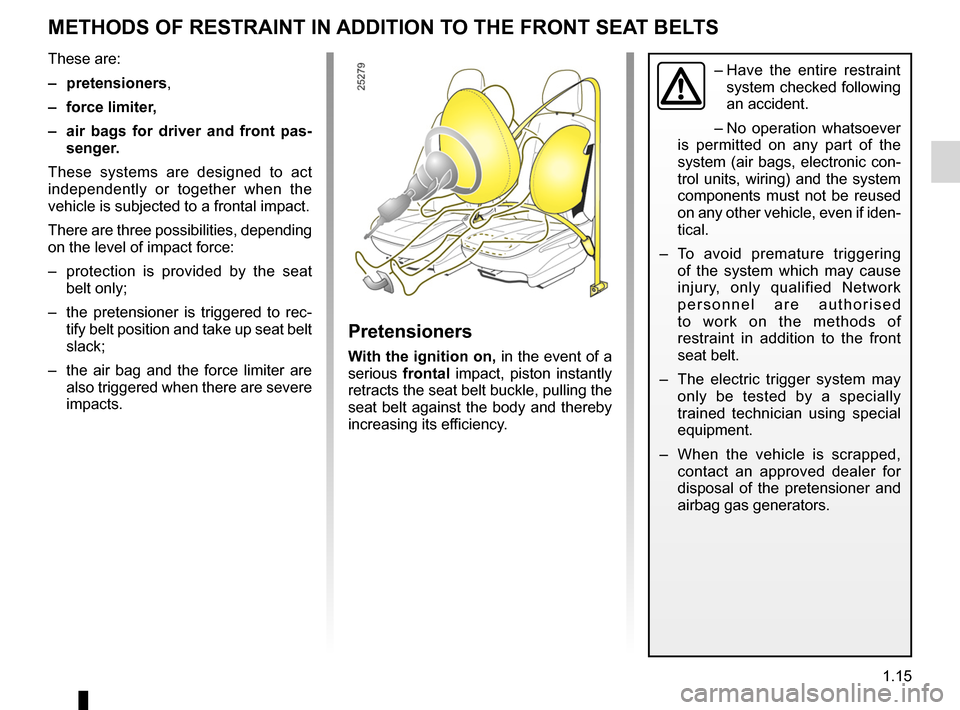
air bag...................................................(up to the end of the DU)seat belts ..............................................(up to the end of the DU)methods of restraint in addition to the front seat belts
(up to the end of the DU)
1.15
ENG_UD8379_3Dispositifs complémentaires à la ceinture avant (B90 - L90 Ph2 - \
Dacia)ENG_NU_817-2_NU_Dacia_1
Methods of restraint in addition to the front seat belts
METHODS OF RESTRAINT IN ADDITION TO THE FRONT SEAT BELTS
These are:
– pretensioners
,
– force limiter,
– air bags for driver and front pas
- senger.
These systems are designed to act independently or together when the vehicle is subjected to a frontal impact.
There are three possibilities, depending on the level of impact force:
– protection is provided by the seat
belt only;
– the pretensioner is triggered to rec
- tify belt position and take up seat belt slack;
– the air bag and the force limiter are
also triggered when there are severe impacts.
– Have the entire restraint system checked following an accident.
– No operation whatsoever
is permitted on any part of the system (air bags, electronic con- trol units, wiring) and the system components must not be reused on any other vehicle, even if iden- tical.
– To avoid premature triggering
of the system which may cause injury, only qualified Network p e r s o n n e l a r e a u t h o r i s e d to work on the methods of restraint in addition to the front seat belt.
– The electric trigger system may
only be tested by a specially trained technician using special equipment.
– When the vehicle is scrapped,
contact an approved dealer for disposal of the pretensioner and airbag gas generators.
Pretensioners
with the ignition on, in the event of a serious frontal impact, piston instantly retracts the seat belt buckle, pulling the seat belt against the body and thereby increasing its efficiency.
Page 21 of 146
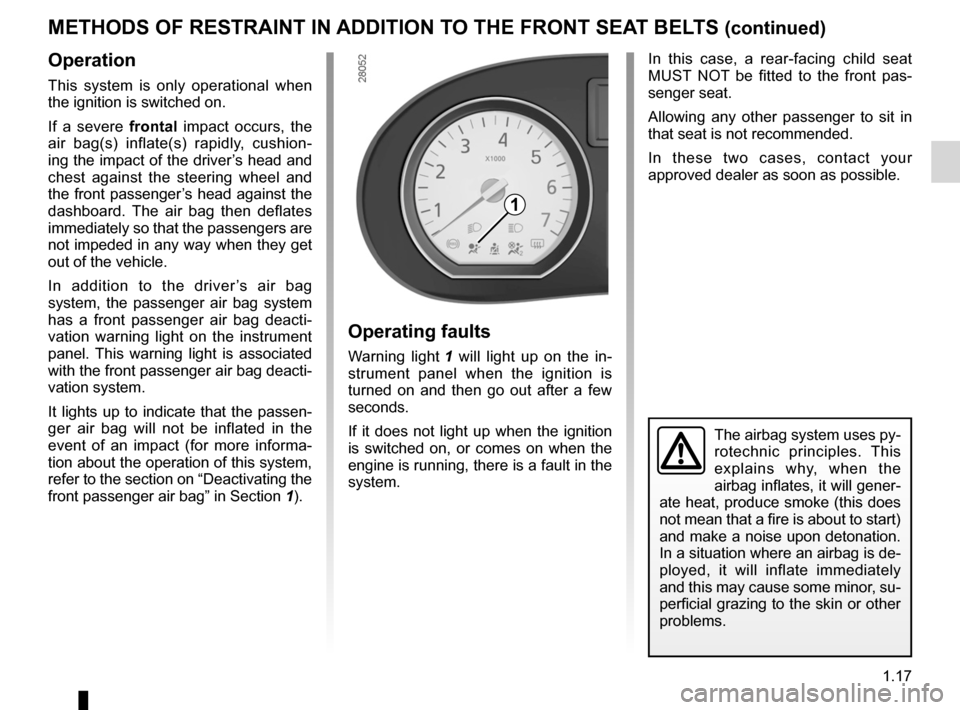
JauneNoirNoir texte
1.17
ENG_UD8379_3Dispositifs complémentaires à la ceinture avant (B90 - L90 Ph2 - \
Dacia)ENG_NU_817-2_NU_Dacia_1
METHODS OF RESTRAINT IN ADDITION TO THE FRONT SEAT BELTS (continued)
Operation
This system is only operational when the ignition is switched on.
If a severe frontal impact occurs, the air bag(s) inflate(s) rapidly, cushion- ing the impact of the driver’s head and chest against the steering wheel and the front passenger’s head against the dashboard. The air bag then deflates immediately so that the passengers are not impeded in any way when they get out of the vehicle.
In addition to the driver ’s air bag system, the passenger air bag system has a front passenger air bag deacti- vation warning light on the instrument panel. This warning light is associated with the front passenger air bag deacti- vation system.
It lights up to indicate that the passen- ger air bag will not be inflated in the event of an impact (for more informa- tion about the operation of this system, refer to the section on “Deactivating the
front passenger air bag” in Section 1).
Operating faults
Warning light 1 will light up on the in- strument panel when the ignition is turned on and then go out after a few seconds.
If it does not light up when the ignition is switched on, or comes on when the engine is running, there is a fault in the system.
In this case, a rear-facing child seat MUST NOT be fitted to the front pas- senger seat.
Allowing any other passenger to sit in that seat is not recommended.
In these two cases, contact your approved dealer as soon as possible.
The airbag system uses py- rotechnic principles. This explains why, when the airbag inflates, it will gener- ate heat, produce smoke (this does not mean that a fire is about to start) and make a noise upon detonation. In a situation where an airbag is de- ployed, it will inflate immediately and this may cause some minor, su-
perficial grazing to the skin or other problems.
1
Page 22 of 146
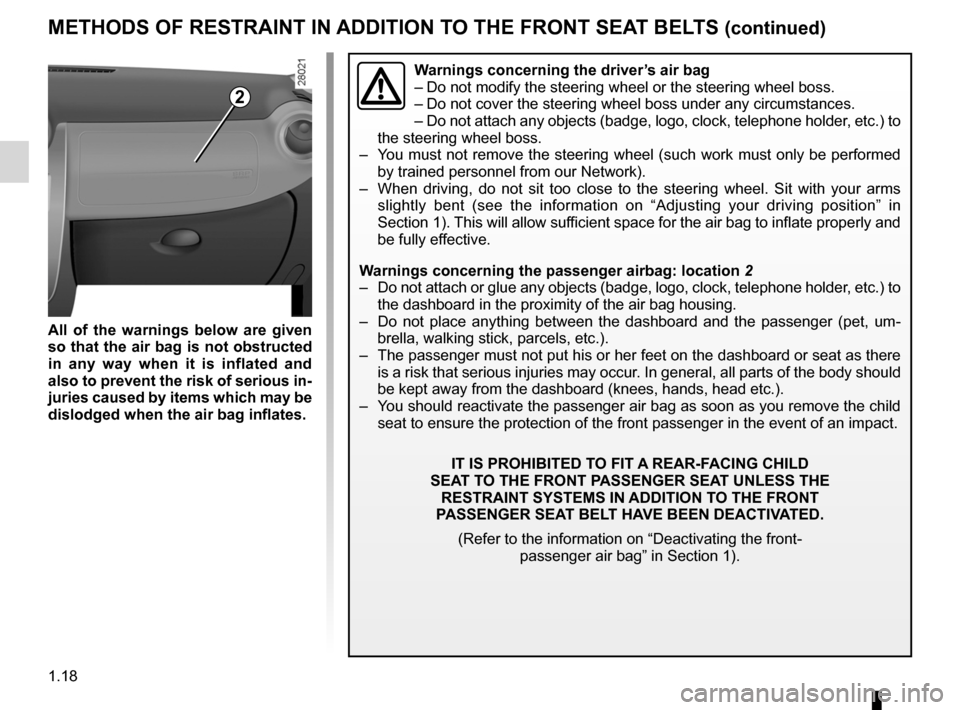
1.18
ENG_UD8379_3Dispositifs complémentaires à la ceinture avant (B90 - L90 Ph2 - \
Dacia)ENG_NU_817-2_NU_Dacia_1
METHODS OF RESTRAINT IN ADDITION TO THE FRONT SEAT BELTS (continued)
All of the warnings below are given so that the air bag is not obstructed in any way when it is inflated and also to prevent the risk of serious in- juries caused by items which may be dislodged when the air bag inflates.
warnings concerning the driver’s air bag
– Do not modify the steering wheel or the steering wheel boss.
– Do not cover the steering wheel boss under any circumstances.
– Do not attach any objects (badge, logo, clock, telephone holder, etc.) to
the steering wheel boss.
– You must not remove the steering wheel (such work must only be performed by trained personnel from our Network).
– When driving, do not sit too close to the steering wheel. Sit with your arms slightly bent (see the information on “Adjusting your driving position” in
Section 1). This will allow sufficient space for the air bag to inflate properly and be fully effective.
w arnings concerning the passenger airbag: location
2
– Do not attach or glue any objects (badge, logo, clock, telephone holder, etc.) to the dashboard in the proximity of the air bag housing.
– Do not place anything between the dashboard and the passenger (pet, um- brella, walking stick, parcels, etc.).
– The passenger must not put his or her feet on the dashboard or seat as there is a risk that serious injuries may occur. In general, all parts of the body should be kept away from the dashboard (knees, hands, head etc.).
– You should reactivate the passenger air bag as soon as you remove the child seat to ensure the protection of the front passenger in the event of an \
impact.
IT IS PROHIBITED TO FIT A REAR-FACING CHILD SEAT TO THE FRONT PASSENGER SEAT UNLESS THE RESTRAINT SYSTEMS IN ADDITION TO THE FRONT
PASSENGER SEAT BELT HA vE BEEN DEACTIvATED.
(Refer to the information on “Deactivating the front- passenger air bag” in Section 1).
2
Page 24 of 146
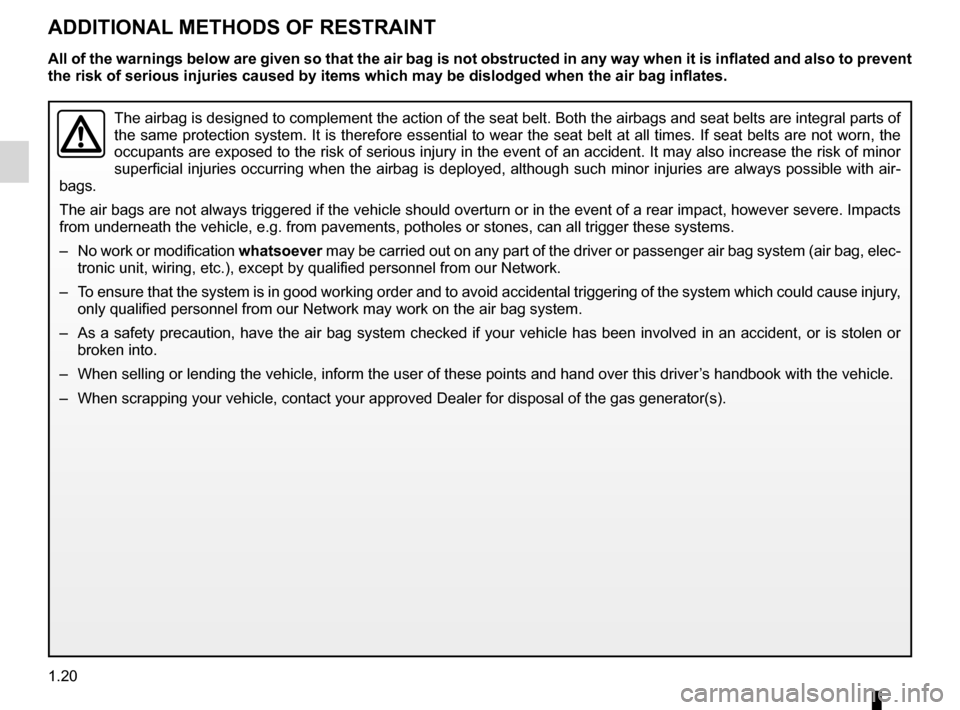
air bag....................................................................(current page)seat belts ...............................................................(current page)methods of restraint in addition to the front seat belts
(current page)
1.20
ENG_UD5554_1Dispositifs de retenue complémentaires (B90 - Dacia)ENG_NU_817-2_NU_Dacia_1
The airbag is designed to complement the action of the seat belt. Both the airbags and seat belts are integral parts of the same protection system. It is therefore essential to wear the seat belt at all times. If seat belts are not worn, the occupants are exposed to the risk of serious injury in the event of an accident. It may also increase the risk of minor superficial injuries occurring when the airbag is deployed, although such minor injuries are always possible with air- bags.
The air bags are not always triggered if the vehicle should overturn or in the event of a rear impact, however severe. Impacts from underneath the vehicle, e.g. from pavements, potholes or stones, ca\
n all trigger these systems.
– No work or modification
whatsoever may be carried out on any part of the driver or passenger air bag system (air bag, elec- tronic unit, wiring, etc.), except by qualified personnel from our Netw\
ork.
– To ensure that the system is in good working order and to avoid accidental triggering of the system which could cause injury,
only qualified personnel from our Network may work on the air bag system\
.
– As a safety precaution, have the air bag system checked if your vehicle has been involved in an accident, or is stolen or
broken into.
– When selling or lending the vehicle, inform the user of these points and hand over this driver’s handbook with the vehicle.
– When scrapping your vehicle, contact your approved Dealer for disposal of the gas generator(s).
All of the warnings below are given so that the air bag is not obstructed in any way when it is inflated and also to prevent the risk of serious injuries caused by items which may be dislodged when\
the air bag inflates.
ADDITIONAL METHODS OF RESTRAINT
Page 30 of 146
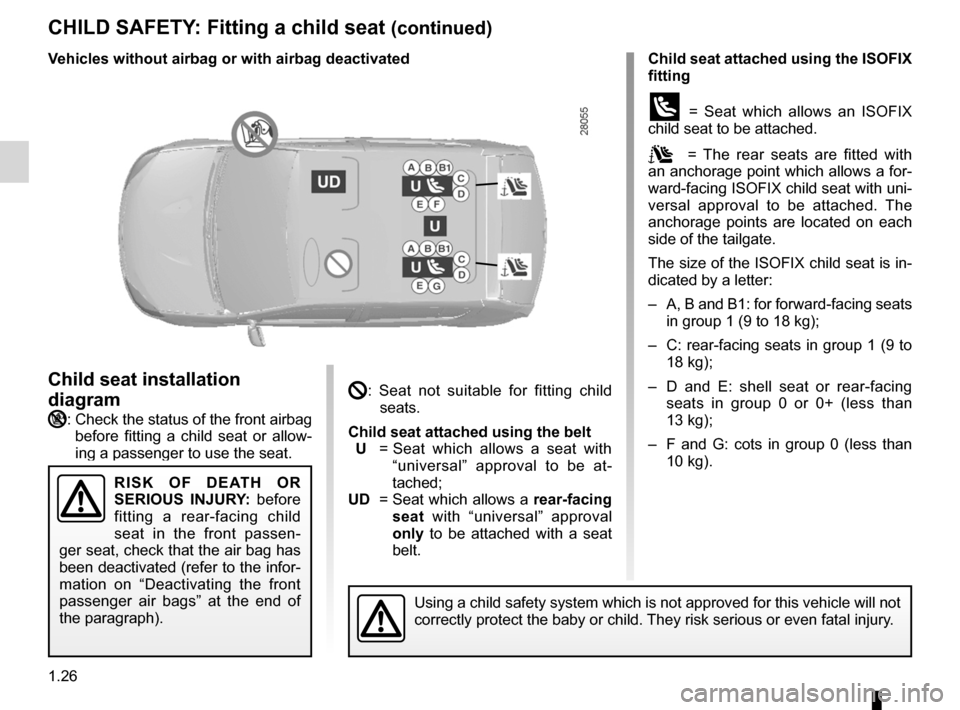
1.26
ENG_UD8389_2Sécurité enfants : installation du siège enfant (B90 - Dacia)\
ENG_NU_817-2_NU_Dacia_1
JauneNoirNoir texte
CHILD SAFETY: Fitting a child seat (continued)
Child seat attached using the ISOFIX fitting
ü = Seat which allows an ISOFIX child seat to be attached.
= The rear seats are fitted with an anchorage point which allows a for- ward-facing ISOFIX child seat with uni- versal approval to be attached. The anchorage points are located on each side of the tailgate.
The size of the ISOFIX child seat is in- dicated by a letter:
– A, B and B1: for forward-facing seats
in group 1 (9 to 18 kg);
– C: rear-facing seats in group 1 (9 to
18 kg);
– D and E: shell seat or rear-facing
seats in group 0 or 0+ (less than
13 kg);
– F and G: cots in group 0 (less than
10 kg).
: Seat not suitable for fitting child seats.
Child seat attached using the belt
U = Seat which allows a seat with “universal” approval to be at- tached;
UD = Seat which allows a rear-facing seat with “universal” approval only to be attached with a seat belt.
Using a child safety system which is not approved for this vehicle will not correctly protect the baby or child. They risk serious or even fatal injury.
Child seat installation
diagram
:
Check the status of the front airbag before fitting a child seat or allow- ing a passenger to use the seat.
R I S K O F D E AT H O R
SERIOUS INJURY: before fitting a rear-facing child seat in the front passen- ger seat, check that the air bag has been deactivated (refer to the infor- mation on “Deactivating the front passenger air bags” at the end of the paragraph).
v ehicles without airbag or with airbag deactivated
Page 31 of 146
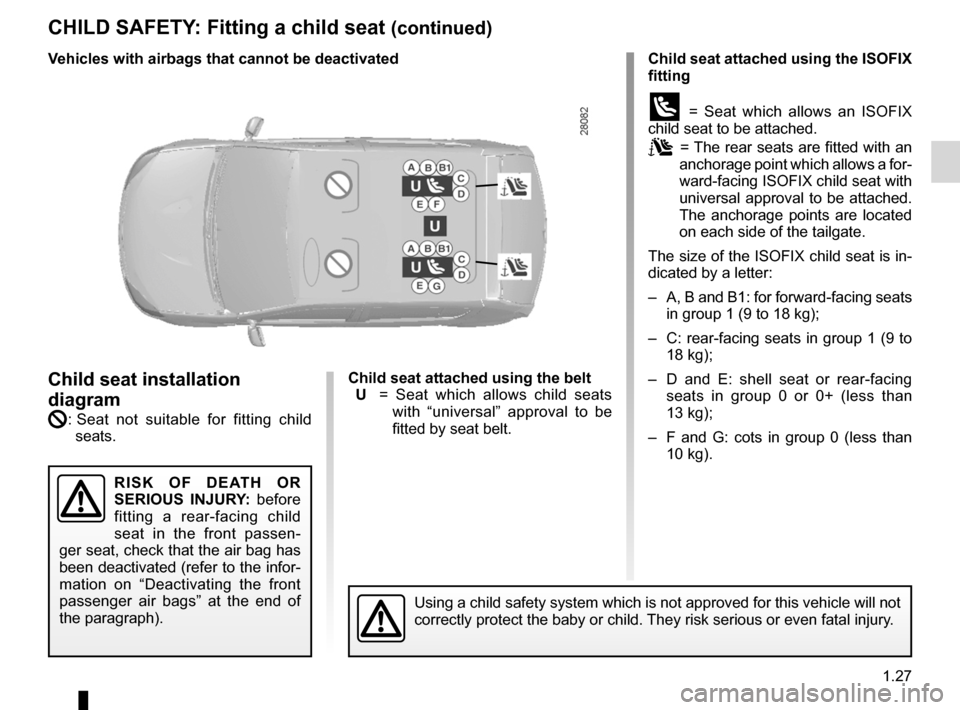
JauneNoirNoir texte
1.27
ENG_UD8389_2Sécurité enfants : installation du siège enfant (B90 - Dacia)\
ENG_NU_817-2_NU_Dacia_1
CHILD SAFETY: Fitting a child seat (continued)
Child seat attached using the ISOFIX fitting
ü = Seat which allows an ISOFIX child seat to be attached.
= The rear seats are fitted with an anchorage point which allows a for- ward-facing ISOFIX child seat with universal approval to be attached. The anchorage points are located on each side of the tailgate.
The size of the ISOFIX child seat is in- dicated by a letter:
– A, B and B1: for forward-facing seats
in group 1 (9 to 18 kg);
– C: rear-facing seats in group 1 (9 to
18 kg);
– D and E: shell seat or rear-facing
seats in group 0 or 0+ (less than
13 kg);
– F and G: cots in group 0 (less than
10 kg).
Child seat attached using the belt
U = Seat which allows child seats with “universal” approval to be fitted by seat belt.
Using a child safety system which is not approved for this vehicle will not correctly protect the baby or child. They risk serious or even fatal injury.
Child seat installation
diagram
: Seat not suitable for fitting child seats.
R I S K O F D E AT H O R
SERIOUS INJURY: before fitting a rear-facing child seat in the front passen- ger seat, check that the air bag has been deactivated (refer to the infor- mation on “Deactivating the front passenger air bags” at the end of the paragraph).
v ehicles with airbags that cannot be deactivated
Page 32 of 146
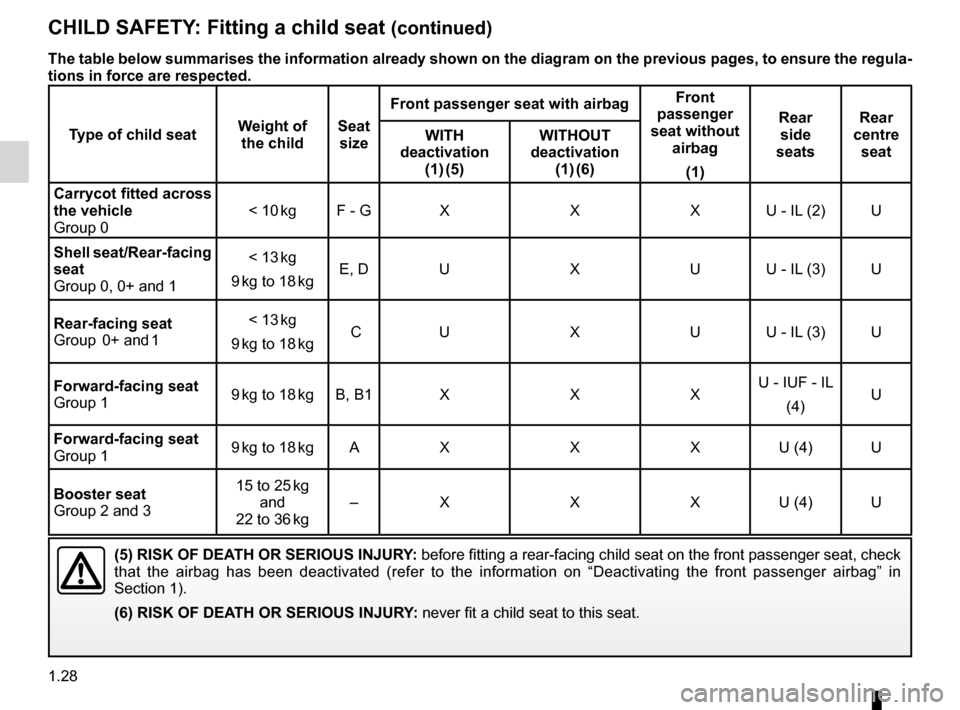
1.28
ENG_UD8389_2Sécurité enfants : installation du siège enfant (B90 - Dacia)\
ENG_NU_817-2_NU_Dacia_1
JauneNoirNoir texte
CHILD SAFETY: Fitting a child seat (continued)
(5) RISK OF DEATH OR SERIOUS INJURY: before fitting a rear-facing child seat on the front passenger seat, check that the airbag has been deactivated (refer to the information on “Deactivating the front passenger airbag” in
Section 1).
(6) RISK OF DEATH OR SERIOUS INJURY: never fit a child seat to this seat.
The table below summarises the information already shown on the diagram on the previous pages, to ensure the regula- tions in force are respected.
Type of child seat w
eight of the childSeat size
Front passenger seat with airbagFront passenger seat without airbag
(1)
Rear side seats
Rear centre seat
wITH deactivation
(1) (5) wITHOUT deactivation
(1) (6)
Carrycot fitted across the vehicleGroup 0< 10 kgF - GXXXU - IL (2)U
Shell seat/Rear-facing seatGroup 0, 0+ and 1
< 13 kg
9 kg to 18 kgE, DUXUU - IL (3)U
Rear-facing seat
Group 0+ and 1< 13 kg
9 kg to 18 kg CUXUU - IL (3)U
Forward-facing seatGroup 19 kg to 18 kgB, B1XXXU - IUF - IL
(4)U
Forward-facing seatGroup 19 kg to 18 kgAXXXU (4)U
Booster seatGroup 2 and 3
15 to 25 kg
and 22 to 36 kg–XXXU (4)U
Page 34 of 146
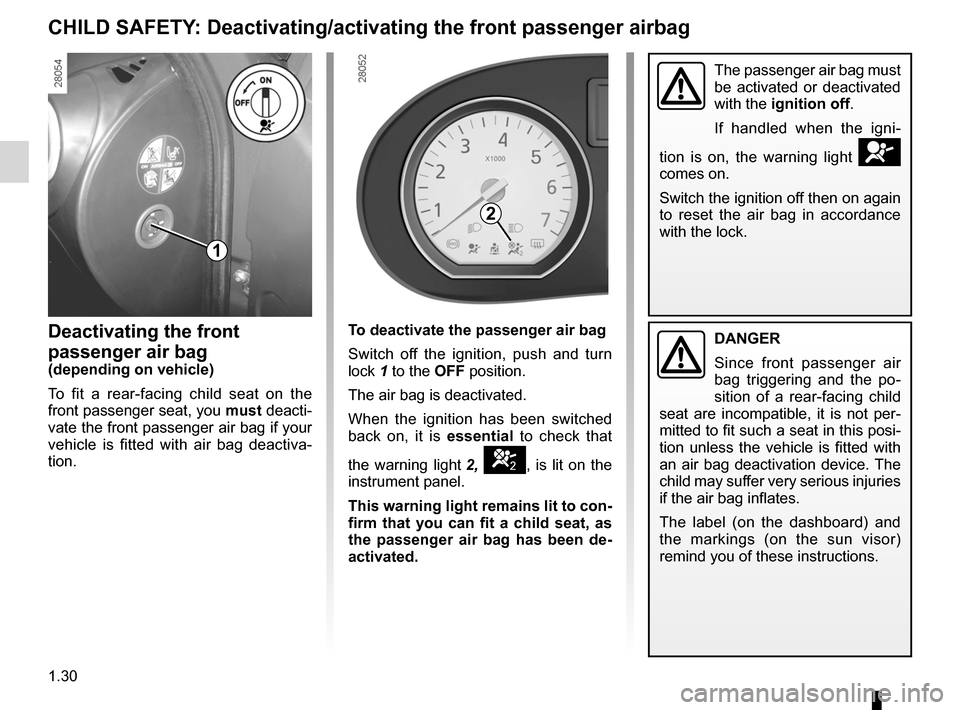
air bagdeactivating the front passenger air bags ........(current page)front passenger air bag deactivation .....................(current page)
1.30
ENG_UD6854_1Sécurité enfants : désactivation/activation airbag passager ava\
nt (B90 - Dacia)ENG_NU_817-2_NU_Dacia_1
JauneNoirNoir texte
désactivation / activation de l’airbag passager avant
CHILD SAFETY : Deactivating/activating the front passenger airbag
The passenger air bag must be activated or deactivated with the ignition off.
If handled when the igni-
tion is on, the warning light å comes on.
Switch the ignition off then on again to reset the air bag in accordance with the lock.
To deactivate the passenger air bag
Switch off the ignition, push and turn
lock 1 to the OFF position.
The air bag is deactivated.
When the ignition has been switched back on, it is essential to check that
the warning light
2, ], is lit on the instrument panel.
This warning light remains lit to con- firm that you can fit a child seat, as the passenger air bag has been de- activated.
Deactivating the front
passenger air bag(depending on vehicle)
To fit a rear-facing child seat on the front passenger seat, you must deacti- vate the front passenger air bag if your vehicle is fitted with air bag deactiva- tion.
DANGER
Since front passenger air bag triggering and the po- sition of a rear-facing child seat are incompatible, it is not per- mitted to fit such a seat in this posi- tion unless the vehicle is fitted with an air bag deactivation device. The child may suffer very serious injuries if the air bag inflates.
The label (on the dashboard) and the markings (on the sun visor) remind you of these instructions.
1
2